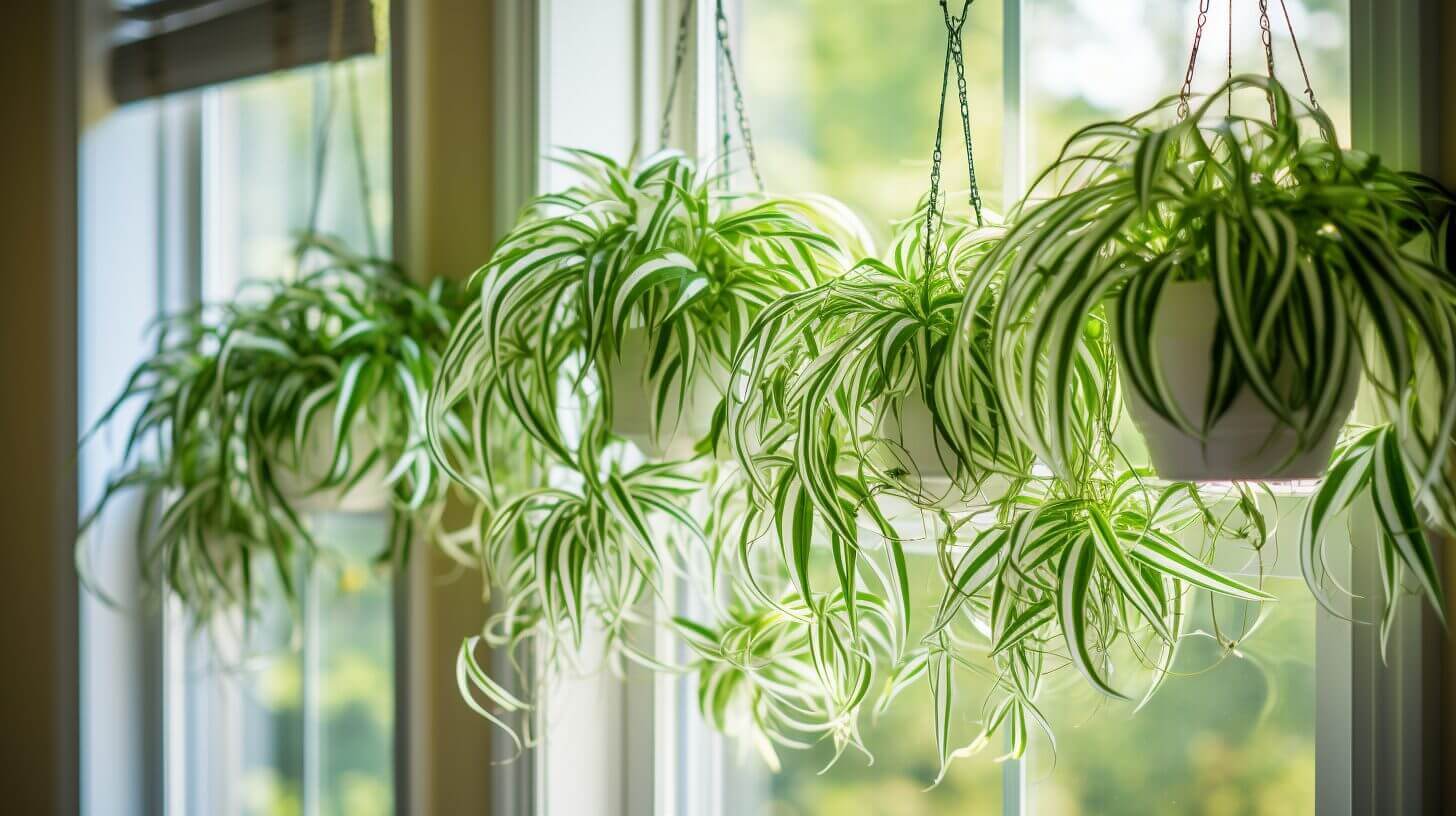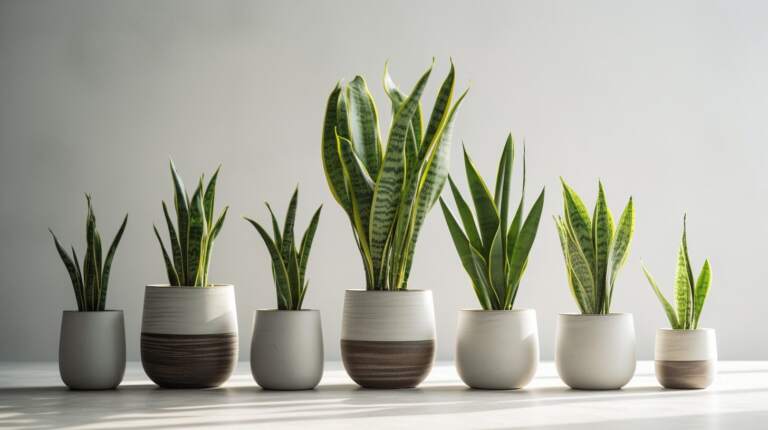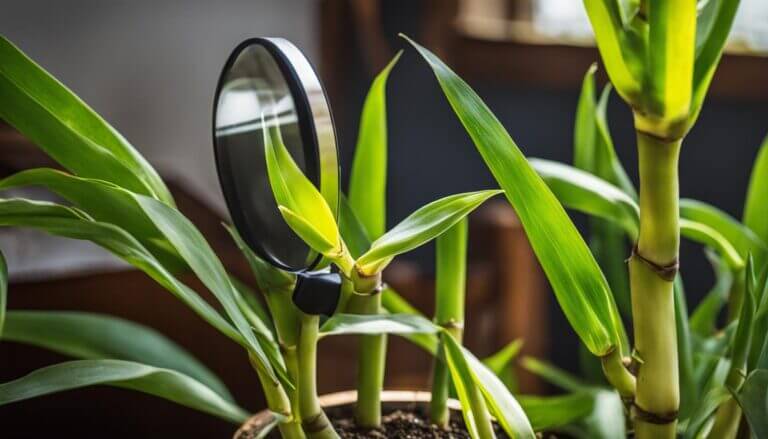How Big Can Spider Plants(Chlorophytum Comosum) Get? Maximum Growth Size Explained
Did you know that spider plants can grow up to 2 feet long and 2 feet wide? Understanding the factors that contribute to their size can help you create optimal conditions for maximum growth. Some common names for spider plant are “Airplane Plant”, “Ribbon Plant”, and “Spider Ivy”.
In this article, we will explore the role of pot size, light, temperature, and other factors that impact the size of spider plants. By following our tips, you’ll be able to encourage the largest possible growth in your spider plants, creating a stunning display for your home or office.
Key Takeaways
- Spider plants thrive in bright, indirect light and well-draining soil.
- Understanding the factors that affect spider plant growth, such as sunlight, soil composition, watering frequency, and pot size, is crucial.
- The size of the pot plays a significant role in determining the overall size of the spider plant, as it allows for root development and sunlight exposure.
- Adequate lighting, temperature, humidity, and regular fertilization are important for maximum growth in spider plants.
Factors Affecting Indoor Spider Plant Size
One of the most important factors affecting the size of spider plants is the amount of sunlight they receive. Spider plants thrive in bright, indirect light, so placing them near a window with filtered sunlight is ideal. Insufficient sunlight can cause stunted growth and smaller overall size.
Another factor that impacts spider plant size is the composition of the soil. Spider plants prefer well-draining soil, as excessive moisture can lead to root rot and hinder growth. It is recommended to use a combination of potting soil and perlite to ensure proper drainage.
Additionally, watering frequency plays a crucial role in the size of spider plants. Overwatering can lead to waterlogged soil, while underwatering can cause dehydration and slow growth. Finding the right balance and providing consistent, adequate watering is essential for promoting maximum growth.
Understanding these factors will help gardeners comprehend spider plant growth patterns and ensure their plants reach their full potential.
Understanding Spider Plant Growth Patterns
To gain a comprehensive understanding of spider plant growth patterns, it is important to observe their development over time and identify the factors that influence their size and overall growth.
Spider plant care plays a crucial role in promoting healthy growth and preventing common spider plant problems. These plants thrive in bright, indirect light and prefer well-draining soil. Proper watering is essential, as spider plants prefer slightly moist soil but can be susceptible to root rot if overwatered.
In terms of growth patterns, spider plants typically produce long, arching leaves that can reach lengths of up to 18 inches. They also produce plantlets, or offshoots, that can be re-potted to create new plants.
Understanding these growth patterns will help us explore the role of pot size in spider plant size in the next section.
The Role of Pot Size in Spider Plant Size
While many factors contribute to the size of spider plants, the pot size they are grown in plays a significant role in determining their overall size and growth. Here are three reasons why pot size is important for spider plant size:
- Root development: Spider plants have a vigorous root system that requires ample space to grow and spread. A larger pot provides more room for the roots to expand, allowing the plant to access more nutrients and water from the soil.
- Sunlight exposure: Pot size affects the amount of sunlight the spider plant receives. A larger pot means more surface area for the leaves to capture sunlight, promoting better photosynthesis and overall growth.
- Soil quality: The pot size influences the quality of the soil and its ability to retain moisture. A larger pot allows for a greater volume of soil, which can hold more water and nutrients, providing optimal conditions for the spider plant’s growth.
How Light and Temperature Impact Spider Plant Growth
The light and temperature conditions significantly affect the growth of spider plants. Light is a crucial factor in the development of spider plants, as they thrive in bright but indirect sunlight. Insufficient light can cause stunted growth and pale leaves, while too much direct sunlight can scorch the foliage.
Maintaining the right temperature is also important for spider plants, as they prefer temperatures between 60 and 75 degrees Fahrenheit. Extreme temperatures can hinder growth and even cause damage to the plant.
Additionally, humidity plays a vital role in spider plant growth. These plants prefer moderate to high humidity levels, as low humidity can lead to dry and brown leaf tips.
Regular fertilization is also essential for promoting spider plant size, as it provides the necessary nutrients for healthy growth.
Tips for Encouraging Maximum Growth in Spider Plants
During the growing season, it is important to provide optimal care and follow specific tips to encourage maximum growth in spider plants. Here are three tips to help you in encouraging spider plant growth and maximizing plant size:
- Provide Adequate Watering: Spider plants thrive in evenly moist soil. Water your spider plant regularly, keeping the soil consistently moist, but not soggy. Avoid overwatering or letting the plant sit in standing water, as this can lead to root rot.
- Ensure Sufficient Lighting: Spider plants prefer bright, indirect light. Place your plant near a window where it can receive bright, filtered sunlight. If the light is too low, the plant may grow slowly or develop leggy growth. Consider using artificial grow lights to supplement natural light if needed.
- Fertilize Regularly: Spider plants benefit from regular fertilization during the growing season. Use a balanced, water-soluble fertilizer, diluted to half strength, and apply it every two to four weeks. This will provide the necessary nutrients for healthy growth and vibrant foliage.
Frequently Asked Questions
Can Spider Plants Be Grown Outdoors?
Growing spider plants outdoors can be a rewarding experience, but it also comes with certain challenges. The benefits of growing spider plants outdoors include increased sunlight exposure, which promotes healthier growth and vibrant foliage.
However, it’s important to consider the climate and temperature requirements of spider plants, as they prefer mild to warm conditions. Providing well-draining soil, regular watering, and protection from extreme weather conditions are key tips for successfully growing spider plants outdoors.
What Is the Lifespan of a Spider Plant(Chlorophytum Comosum)?
The lifespan of a spider plant can vary depending on its care and environment. Spider plants are known for their long-lasting nature, with some living up to several years. Proper spider plant care is essential for maintaining their health and longevity. This includes providing them with adequate light, water, and well-draining soil.
Spider plants can also be propagated through various methods, such as division or by using their offshoots, to ensure their continued growth and success.
Do Spider Plants Require Any Special Kind of Soil?
Spider plants do not require any special kind of soil. They are adaptable and can grow in a variety of soil types, ranging from sandy to loamy. However, they thrive in well-draining soil that is rich in organic matter. A good potting mix that consists of equal parts peat moss, perlite, and vermiculite is often recommended for spider plants.
This type of soil provides the necessary nutrients and moisture retention while allowing excess water to drain away to prevent root rot.
Is there a way to control the growth of spider plants to prevent them from getting too big?
Spider plant growth tips can help control the size of these plants. To prevent them from becoming overly big, ensure they are placed in small pots to restrict root growth. Regularly trim the foliage to keep it in check and remove any flowers or runners that may appear. Last but not least, limit the amount of fertilizer you use, as excessive nutrients can lead to faster growth.
Can Spider Plants Grow in Low Light Conditions?
Spider plants can indeed grow in low light conditions, making them a popular choice for indoor spaces with limited natural light. In fact, low light can have certain benefits for spider plants, such as promoting fuller growth and preventing excessive leaf browning.
To successfully grow spider plants in low light environments, it is advisable to place them near a north-facing window, use artificial grow lights, or even rotate them to ensure all sides receive some light. Adequate watering and well-draining soil are also important factors for their growth.
How Often Should Spider Plants Be Watered?
Spider plants should be watered regularly, but not excessively. The frequency of watering depends on factors such as the temperature, humidity, and pot size. Overwatering can lead to root rot, while underwatering can cause the plant to wilt and have brown tips on the leaves.
It is important to monitor the soil moisture and water when the top inch feels dry. Using distilled water can be beneficial as it helps prevent the buildup of salts and minerals that can damage the plant.
How do I care for a spider plant?
Caring for a spider plant involves providing it with indirect sunlight, watering it with tap water when the top inch of soil is dry, and maintaining indoor humidity levels.
How does humidity affect spider plants?
Spider plants like high humidity. If the air is too dry, the plant leaves may turn brown.
How do I propagate a spider plant?
Propagate a spider plant by cutting off the baby spider plants, or spiderettes, and planting them in new pots.
When should I repot a spider plant?
You should repot a spider plant when it becomes root-bound, which is often indicated by roots growing out of the drainage hole.
How do I prune a spider plant?
Prune a spider plant by cutting off any brown tips or dead leaves. This encourages new growth and keeps your spider plant looking fresh.
How do I grow spider plants?
Spider plants are easy to care for and grow well in indirect sunlight. They prefer to be slightly root-bound in their pots.
What are some tips for propagating spider plants?
When propagating spider plants, make sure to cut the spiderettes off the parent plant and place them in a pot with well-draining soil.
How do I care for spider plants indoors?
Indoor care for spider plants involves providing them with bright, indirect light, watering them moderately, and maintaining high humidity levels.
What are some different varieties of spider plants?
There are several varieties of spider plants including the common green variety (Chlorophytum comosum), the variegated variety (Chlorophytum comosum ‘Variegatum’), and the reverse variegated variety (Chlorophytum comosum ‘Reverse Variegatum’).
What are some care tips for spider plants?
Some care tips for spider plants include providing them with bright, indirect light, watering them when the top inch of soil is dry, and maintaining high indoor humidity levels.
What types of spiders are there in spider plants?
The term “spiders” in “spider plants” refers to the plant’s spider-like appearance and its spiderettes or baby plants that dangle from the mother plant like spiders on a web.
What are some common questions about spider plant care?
Some common questions about spider plant care include how often to water them, what type of light they need, how to propagate them, and how to deal with common pests like spider mites.
Can I use a spider plant as a houseplant?
Yes, spider plants make excellent houseplants. They are easy to care for and can thrive in a variety of indoor conditions.
Does the Size of a Spider Plant Impact Its Sunlight Needs?
The size of a spider plant does not significantly impact its sunlight needs. Spider plant light requirements remain consistent regardless of their size. These resilient houseplants thrive in bright, indirect light. They can tolerate some shade but should be kept away from direct sunlight, as it can lead to scorching of their delicate leaves.
Can I use fertilizer on my spider plant?
Yes, you can use a balanced houseplant fertilizer on your spider plant during the spring and summer growth period. However, be careful not to over-fertilize as this can cause brown tips on the leaves.
How do I propagate my spider plant babies?
Propagate your spider plant babies by cutting them off from the main plant once they have developed roots. You can then plant them in their own pots.







